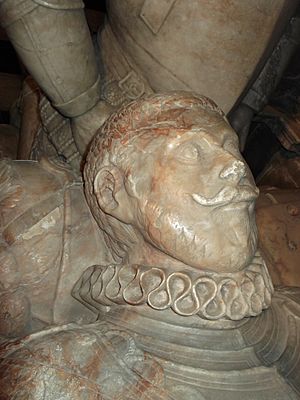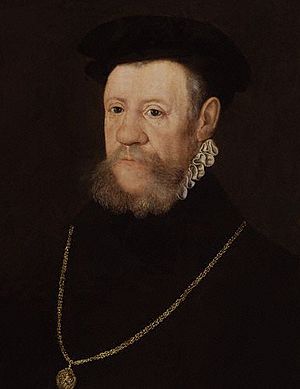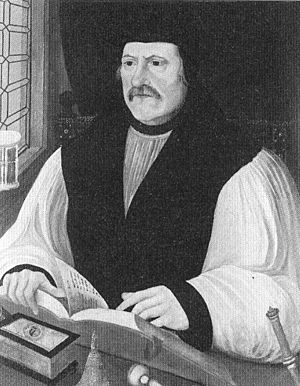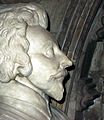Gilbert Gerard (judge) facts for kids
Sir Gilbert Gerard (died 1593) was an important lawyer, politician, and landowner in the Tudor period (when the Tudors ruled England). He was elected to the English parliament six times. He served as the main lawyer for the Queen, called the Attorney-General, for over 20 years during the reign of Elizabeth I. He also held other big jobs, like vice-chancellor of the Duchy of Lancaster and later Master of the Rolls, which meant he was a very senior judge. He bought a lot of land, mostly in Lancashire and Staffordshire.
Contents
Gilbert's Early Life and Family
Gilbert Gerard was born around 1523. His father was James Gerard from Astley and Ince, Lancashire. His family had lived in Ince since the late 1300s. However, Gilbert's father was likely a younger son, so Gilbert wasn't expected to inherit the main family lands.
The Gerard family became very successful during Queen Elizabeth I's reign, with Sir Gilbert being the most famous. It can be a bit confusing because many family members had similar names! For example, Sir Gilbert was a cousin of Sir William Gerard, who became a top judge in Ireland. Gilbert also had a younger brother named William and a nephew named William.
Gilbert's mother was Margaret Holcroft. Her family, the Holcrofts, were also becoming important landowners. Margaret's brothers, Sir John and Sir Thomas Holcroft, were Gilbert's uncles. They were brave soldiers in wars against Scotland and made money by buying land from old monasteries. Gilbert's marriage to Anne Radcliffe was even arranged through his uncle Sir John.
Gilbert's Education and Training
Gilbert Gerard studied at the University of Cambridge for a short time, which was common back then. He didn't get a degree.
In 1537, when he was about 16, he joined Gray's Inn. This was one of the special schools in London where people trained to become lawyers. He became a lawyer in 1539. Gilbert was a very good student and was honored by Gray's Inn many times. He became an important teacher (called "Autumn Reader") in 1554 and served as Treasurer in 1556.
Gray's Inn became very important to the Gerard family. Gilbert even had a room there. His nephew William later used the same room, and other family members also joined Gray's Inn.
Gilbert's Time in Parliament
Gilbert Gerard's career as a lawyer and his time in parliament were closely linked. He was elected to parliament six times in total. Four of these times were during the reign of Queen Mary.
Representing Liverpool
Gilbert was first elected as a Member of Parliament (MP) for Liverpool in 1545. Liverpool was part of the Duchy of Lancaster, which was like a special royal estate. Powerful local families, like the Earls of Derby, had a big say in who became MP. It's likely that Edward Stanley, 3rd Earl of Derby, helped Gilbert get this seat. Gilbert was already the Earl's legal advisor.
His uncle, Sir Thomas Holcroft, also helped. Sir Thomas worked for the Duchy of Lancaster and was elected as an MP for Lancashire in the same parliament.
Representing Wigan and Steyning
Gilbert was elected MP for Wigan twice in 1553. The Gerard family had a lot of influence in Wigan, which helped him get elected. The Earl of Derby was also important in the area.
In 1554, Gilbert became MP for Steyning in Sussex. This town was controlled by the royal family, and Henry FitzAlan, 19th Earl of Arundel, had the main say in who became MP. The Earl of Arundel supported Queen Mary, and he was happy to support Gilbert Gerard. Gilbert's uncle, Sir Thomas Holcroft, was also elected for a nearby area.
Gilbert didn't seem to do much as an MP, as his name doesn't appear often in the records. However, he generally supported Queen Mary's government. Even though he later became a strong supporter of Queen Elizabeth, he seemed to be a practical person who accepted the government in power, no matter their religious views. Elizabeth likely chose him for his legal skills, not his religious beliefs.
Later in Parliament
Gilbert was elected to parliament only one more time, much later in his life, in 1584 for Lancashire. By this time, he was the vice-chancellor of the Duchy of Lancaster, which made his election certain. However, because he was also the Master of the Rolls (a very senior judge), he had to attend the House of Lords (even though he wasn't a noble). This meant he couldn't actually sit in the House of Commons as an MP.
Gilbert's Legal Career
Gilbert Gerard became a fully qualified lawyer in 1547. He was known for his legal skills.
Becoming Attorney-General
Gilbert Gerard became the Attorney-General on January 22, 1559, just a week after Queen Elizabeth I became Queen. He was still quite young for such a big job. He helped reform the legal system in Ireland and worked on many church-related legal matters. He was part of the Ecclesiastical Commission, which dealt with church laws. He also helped the University of Cambridge get a law passed to protect its rights.
Gilbert was appointed to important legal jobs all over the country, including being a Justice of the Peace in many counties. In 1573, he became the main administrative official for Middlesex county.
He was also very involved in protecting Queen Elizabeth from plots. In 1570, he helped try people involved in the Rising of the North, a rebellion against the Queen. In 1571, he helped question and prosecute those involved in the Ridolfi plot, which aimed to overthrow Elizabeth. He even helped question important figures like the Duke of Norfolk.
Gilbert Gerard and Thomas Bromley, another top lawyer, often worked together to solve legal problems. Even though Bromley was younger, he was made Lord Chancellor (the most senior judge) in 1579. Gilbert was made a knight that same year.
Being Attorney-General was a good way to earn money. Gilbert could get special grants and use his influence to help others, which also brought him wealth. Most importantly, it gave him a lot of power through the Duchy of Lancaster, which controlled much of northern England. He gained many important roles within the Duchy, becoming its vice-chancellor in 1571. This gave him huge political power.
Becoming Master of the Rolls
In 1581, Gilbert was promoted to Master of the Rolls. This was the second most senior judge in England and the main administrator of the Court of Chancery. While it wasn't as high as Lord Chancellor, it was very rewarding financially. He earned a lot of money from fines and legal documents. He also had the power to appoint many people to jobs, which meant he could make even more money.
As Master of the Rolls, Gilbert was still involved in important trials. He was a judge in the case of William Davison, who was blamed for the execution of Mary, Queen of Scots. Davison was fined and imprisoned, but later released. This case was seen as unfair by some historians.
While Gilbert was a great judge, he wasn't as good at administration. His departments became messy, especially as he got older and became ill. He died on February 4, 1593.
Gilbert's Land and Property
Even though Gilbert wasn't expected to inherit much land, he managed to build up a large amount of property on his own. He did this by taking advantage of opportunities from his legal work and family connections. Through his wife, he got the Damhouse at Astley. He also owned land in other parts of England.
He bought more land from his cousin, Sir Thomas Gerard of Bryn. Sir Thomas was a Catholic and had to sell some of his property after being involved in a plot to free Mary, Queen of Scots. Gilbert bought lands around Ashley, Staffordshire. He built a very large house there called Gerrard's Bromley, which became the main home for his family branch.
Gilbert's Marriage and Children
Gilbert Gerard married Ann Radcliffe. Her father died when she was young, so she became a ward of Gilbert's uncle, Sir Thomas Holcroft. She inherited Damhouse. Ann remained a Catholic throughout her life.
Gilbert and Ann had two sons:
- Thomas: He was Gilbert's main heir and later became the first Baron Gerard.
- Ratcliffe: He married a wealthy heiress and had several children, including:
They also had at least four daughters:
- Frances: Married Richard Molyneux, an important landowner. Their son became the first Viscount Molyneux.
- Radclyffe: Married Sir Thomas Wingfield.
- Catherine: Married Richard Hoghton, another Lancashire landowner.
- Margaret: Married Peter Legh, who was also a lawyer at Gray's Inn.
Gilbert's Death and Burial
Gilbert Gerard made his will on January 8, 1593, and died on February 4, 1593. He was buried in Ashley, Staffordshire, on March 6. There was some confusion about the year of his death because of different calendar styles used at the time.
In his later years, some people suspected Gilbert of secretly supporting Catholics, even though he was a Protestant in public. His wife and at least two of his daughters were known Catholics. However, Gilbert's will showed his strong Protestant beliefs, saying he trusted in God's grace and not his own actions for salvation.
He left gifts to his sons-in-law and money for his unmarried daughter's wedding. His wife received her jewelry and household items.
- The Gerard family memorial in Ashley parish church
-
Anne Radcliffe's Talbot dog at her feet on the memorial.
Gilbert Gerard has a very detailed memorial in Ashley parish church. It was built under the direction of his son, Thomas. The main part shows Gilbert and Anne lying down. Anne has her Talbot dog by her side, and Gilbert is shown in full armor. Kneeling figures of their children were added later. The monument is topped with a large, decorated canopy showing the family's coats of arms.
This memorial is considered one of the largest Elizabethan monuments in England. It was likely made by sculptors from Burton upon Trent, a center for carving in alabaster stone during that time.















